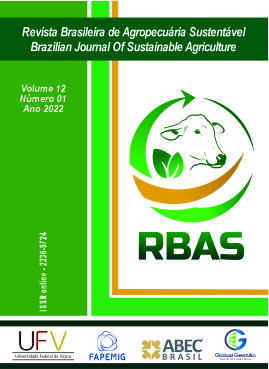AGRONOMIC PERFORMANCE OF LINSEED AS A FUNCTION OF PLANT ARRANGEMENT
DESEMPENHO AGRONÔMICO DA LINHAÇA EM FUNÇÃO DO ARRANJO DA PLANTA
DOI:
https://doi.org/10.21206/rbas.v12i1.14001Keywords:
Linum usitatissimum L., linear relationships, indirect selection, seeding density, row spacing.Abstract
The objective of this work was to understand the agronomic performance of flaxseed cultivated in different spacings between rows and plant density, identifying associations between traits for indirect selection. The experiment was carried out in the municipality of Augusto Pestana - RS, in the years 2020 and 2021, using a randomized block experimental design organized in a 6x3x2 three-factor scheme, with six sowing densities (30, 60, 90, 120, 150 and 180 plants per linear meter), three spacings between rows (0.18 m, 0.36 m, .0.54 m), and two crop seasons (2020 and 2021). In ten plants per plot, plant height, height of insertion of the first capsule, number of basal branches, stem diameter, number of branches on the stem, number of main branches, number of capsules, mass of capsules, number of grains per plot were measured. plant, weight of one hundred grains and weight of grains per plant. In addition, grain yield and plant stand were estimated. Grain yield is enhanced in row spacing of 18 cm with densities of 65 seeds per linear meter in crops with favorable conditions. In flaxseed, the number of capsules, number of grains and the mass of grains per plant exhibit a linear association with grain yield and can be used for indirect selection.
Downloads
Downloads
Published
How to Cite
Issue
Section
License
Copyright (c) 2022 Brazilian Journal of Sustainable Agriculture

This work is licensed under a Creative Commons Attribution-NonCommercial-NoDerivatives 4.0 International License.
1. Proposta de Política para Periódicos de Acesso Livre
Autores que publicam nesta revista concordam com os seguintes termos:
Autores mantém os direitos autorais e concedem à revista o direito de primeira publicação, com o trabalho simultaneamente licenciado sob a Licença Creative Commons Attribution que permite o compartilhamento do trabalho com reconhecimento da autoria e publicação inicial nesta revista.











